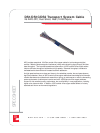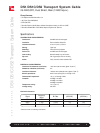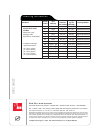
9/06 • 101300AE
DS1/DS1C/DS2 Transport System Cable
DS1/DS1C/DS2 Transport System Cable
26 AWG STC, Dual Shield, Riser (1249C Equiv.)
2
www.adc.com • +1-952-938-8080 • 1-800-366-3891
Benefits
• Combines innovative design and application engineering to deliver a cabling solution that exceeds
your network's physical layer requirements
• Offers improved crosstalk and attenuation performance to deliver the bandwidth required for digital
voice, data and video
• Helps eliminate throughput bottlenecks and service downtime, improving customer satisfaction
• Provides consistent product quality
- No missing insulation, no excess adhesion
- Tangle-free, kink-free
- Jacket and insulation concentricity and cable roundness
- Small outside diameter and cross-sectional area in bundles and cable
- Streamlined engineering, production and quality processes
- In-process manufacturing quality inspections
• Meets or exceeds industry requirements and environmental regulations
- Heavy-metal free (i.e. cadmium, lead, mercury, etc.)
- Compliant to Directive 2002/95/EC Restriction of the use of certain Hazardous Substances (RoHS)
and other known environmental regulations
• Provides exceptional design and enhanced electrical and mechanical performance.
• Adheres to strict industry tolerance standards and customer specifications for use throughout major
service provider networks around the world
Common Applications
• Central office, including main distribution frames, collocation, digital switching and transmission
equipment
• Outside plant networks, including CEV’s, cabinets, remote terminals, and at customer premise
• FTTN, where copper cable is required from the ONT to the MDU
• Cable assemblies to connect active equipment in CO, OSP and customer premise
• Copper Broadband Technologies, including
- Digital Voice, Data (xDSL) and Video (IPTV)
- DS1/T1
- DS2/T2
- DS1C
- Basic and Primary Rate ISDN
- 4/16 Mbps Token Ring (IEEE 802.5)
- 10BASE-T (IEEE 802.3)
- 52 Mbps ATM (ATM Forum)
- 100BASE-T4 (Fast Ethernet)
- 100VG-AnyLAN (IEEE 802.12)






